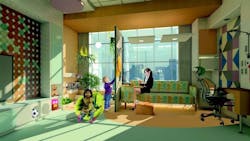Creating child-friendly healthcare spaces: Five goals for success
When we think of healthcare communities and children, we commonly picture them in a campus-wide daycare center that serves staff and their children or as patients in the pediatric department. But children are present in healthcare settings in other ways that are little understood, not often studied, and rarely designed for.
Naturally, children often must accompany their parents (even grandparents) to the adult’s diagnostic and treatment activities whether in an inpatient or outpatient setting. We tend to view the presence of children as pleasant and joyful, but the truth is that children accompany adults in all kinds of everyday situations, some mundane and some uncomfortable.
We know very little about the impact of the presence of children on the ability for quality healthcare to occur. The truth is that children accompanying adults in the healthcare setting can be an impediment to both the patient seeking care and the caregiver’s ability to work.
When parents are hospitalized
How can the design of healthcare settings accommodate children when their parents are being hospitalized? Several years ago, Jingfen Guo’s winning Interior Design Educators Council (IDEC) competition thesis (advised by Professor Jihyun Song at Iowa State University) answered that little-asked question with a design for a convertible patient room that can accommodate children when their parents are hospitalized in an inpatient setting. Below we expand on this intriguing challenge with a look at both inpatient and outpatient settings and their challenges, with strategies for addressing these potential impediments.
Design characteristics to consider
The question to ponder is what constitutes a cohesive patient room environment for a hospitalized parent and their children? What characteristics would define this space? How would this space be addressed when a parent may be seeking medical care in an outpatient setting, such as the local doctor’s office, or the OB/GYN clinic?
Creation of a child-friendly space includes addressing the unique physical and biological characteristics that make children vulnerable to environmental hazards while providing a rich and educational environment containing a variety of stimuli and activities. We believe a child-friendly patient room must provide an interior environment that is therapeutic, controllable, and engageable for both patient and their children.
Below, we have identified five fundamental goals for the patient room that can ensure that we create a sustainable, efficient, and safe space for our younger guests in healthcare settings.
1. Engagement of the child
During their time at home or school, children tend to keep busy with some combination of work, play, or entertainment. It is important to design environments at the hospital where children can stay similarly engaged and active. In Professor Guo’s design, a “Family Zone” (see above) provides an enlarged magnetic white board where the kids can draw. In the sensory corner, children or parents can smell, touch, and care for plant life.
2. A sense of control
In the home, children have their own spaces and can decide where to sit and what to do. In Professor Guo’s design, one of the main goals is to create a positive space where the family feels empowered by a sense of control. This includes the ability to set temperature and lighting, and adjust the use of the space and furniture. Features such as flexible storage compartments give children a place to store a backpack or toy. (see Footwall above).
3. Safe environment
The child-friendly environment must keep children safe from both infection and accidental collisions while promoting physical comfort. We can help create this environment by designing and specifying products that look good and function well. We can minimize sharp corners in furnishings, for example, or specify a slip-resistant rubber floor that attenuates sound. Elsewhere, we can suggest adjustable ergonomic furniture that accommodates children and prevents injury.
4. Therapeutic environment
The primary function of the patient room is to provide a healing environment for the adult. A calm parent not only heals faster but helps put the children at ease. Natural materials, soothing colors, and adjustable access to natural light can promote healing and a feeling of well-being. Acoustic panels in inspiring hues and patterns can help minimize noise to help shape that calm environment. While plant life (where infection control measures allow) can add another layer to that peaceful atmosphere.
5. Multiple functions
It’s a supreme design challenge to maximize services in the limited space of a patient room. Wherever possible, furniture specified should serve multiple functions to engage both parent and child. For example, the family couch should incorporate charging capability, a fold-out table and lamp for reading and drawing, all tying back into item number one, engagement.
